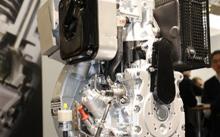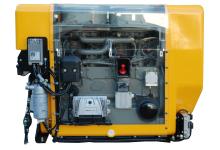Hatz’s Diesel’s 1D81 Hydro concept has been developed to offer a low noise level solution for applications using single-cylinder diesel engines. Still at prototype stage, the 667cc and 772cc capacity single-cylinder engine is a new variant of an existing Hatz engine design. As such, it uses common components from the Hatz range, but it differs with an all-new cylinder block and cylinder head design that includes a water jacket, allowing liquid cooling to be introduced.
1D81 Hydro uses an integrated liquid cooling system that avoids the need for hoses
Still at prototype stage, the 667cc and 772cc capacity single-cylinder engine is a new variant of an existing Hatz engine design. As such, it uses common components from the Hatz range, but it differs with an all-new cylinder block and cylinder head design that includes a water jacket, allowing liquid cooling to be introduced.
Cleverly, there are no coolant hoses on the engine – the combined header tank and radiator pack is incorporated into the engine’s assembly, with redirected airflow from the engine’s flywheel being passed through the radiator core.
“We have reached a point in engine development where we cannot make our basic air-cooled engines any quieter,” said Bernhard Richter-Schutzeneder, head of marketing for Hatz Diesel. “Using water-cooling affords that additional level of noise suppression, but it brings additional advantages too.
“We can now extract more power – typically, up to 20% more than the air-cooled equivalent,” he said. “Engine temperature is kept at a constant 85 degrees C, which helps us to increasing engine life and extend service intervals.”
Stand: A4, 423/528
View more videosView more stories







